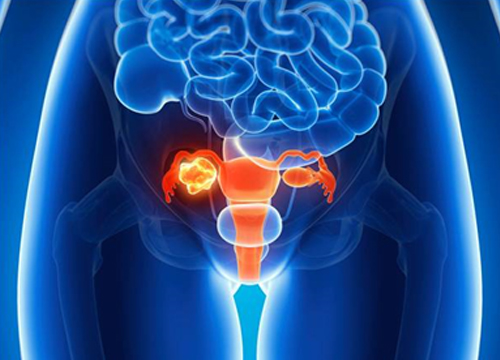
Gynecologic cancer is any cancer that starts in a woman’s reproductive organs. Cancer is always named for the part of the body where it starts. Gynecologic cancers begin in different places within a woman’s pelvis, which is the area below the stomach and in between the hip bones.
Types of Gynecologic Cancer :
● Cervical Cancer : Cervical cancer begins in the cervix, which is the lower, narrow end of the uterus. (The uterus is also called the womb.)● Ovarian Cancer : Ovarian cancer begins in the ovaries, which are located on each side of the uterus.
● Uterine Cancer : Uterine cancer begins in the uterus, the pear-shaped organ in a woman’s pelvis where the baby grows when she is pregnant.
● Vaginal cancer : Vaginal cancer begins in the vagina, which is the hollow, tube-like channel between the bottom of the uterus and the outside of the body.
● Vulvar cancer : Vulvar cancer begins in the vulva, the outer part of the female genital organs.
Ovarian Cancer

Ovarian cancer is a group of diseases that originates in the ovaries, or in the related areas of the fallopian tubes and the peritoneum. Women have two ovaries that are located in the pelvis, one on each side of the uterus. The ovaries make female hormones and produce eggs. Women have two fallopian tubes that are a pair of long, slender tubes on each side of the uterus. Eggs pass from the ovaries through the fallopian tubes to the uterus. The peritoneum is the tissue lining that covers organs in the abdomen.
When ovarian cancer is found in its early stages, treatment works best. Ovarian cancer often causes signs and symptoms, so it is important to pay attention to your body and know what is normal for you. Symptoms may be caused by something other than cancer, but the only way to know is to see your doctor, nurse, or other health care professional.
Ovarian cancers come in a variety of different tumor types. The most common tumor type is high-grade serous carcinoma, occurring in about 70% of ovarian cancer cases.
There is no way to know for sure if you will get ovarian cancer. Most women get it without being at high risk. However, several factors may increase a woman’s risk for ovarian cancer, including if you.
● Are middle-aged or older.● Have close family members (such as your mother, sister, aunt, or grandmother) on either your mother’s or your father’s side, who have had ovarian cancer.
● Have genetic mutations (abnormality) called BRCA1 or BRCA2, or one associated with Lynch syndrome.
● Have had breast, uterine, or colorectal (colon) cancer.
● Have never given birth or have had trouble getting pregnant.
Ovarian cancer may cause the following signs and symptoms :
● Vaginal bleeding (particularly if you are past menopause), or discharge from your vagina that is not normal for you.● Pain or pressure in the pelvic area.
● Abdominal or back pain.
● Bloating.
● Feeling full too quickly or difficulty eating.
● A change in your bathroom habits, such as more frequent or urgent need to urinate and/or constipation.
Treatment for ovarian cancer usually involves a combination of surgery and chemotherapy :
● Surgery : Doctors remove cancer tissue in an operation.● Chemotherapy : Using special medicines to shrink or kill the cancer. The drugs can be pills you take or medicines given in your veins, or sometimes both.
Different treatments may be provided by different doctors on your medical team :
● Surgeons are doctors who perform operations.● Medical oncologists are doctors who treat cancer with medicine (chemotherapy).
Uterine Cancer

When cancer starts in the uterus, it is called uterine cancer. The uterus is the pear-shaped organ in a woman’s pelvis (the area below your stomach and in between your hip bones). The uterus, also called the womb, is where the baby grows when a woman is pregnant. The most common type of uterine cancer is also called endometrial cancer because it forms in the lining of your uterus, called the endometrium.
All women are at risk for uterine cancer, but the risk increases with age. Most uterine cancers are found in women who are going through or who have gone through menopause—the time of life when your menstrual periods stop.
Uterine cancer may cause vaginal discharge or bleeding that is not normal for you. Bleeding may be abnormal because of how heavy it is or when it happens, such as after you have gone through menopause, between periods, or any other bleeding that is longer or heavier than is normal for you. Uterine cancer may also cause other symptoms, such as pain or pressure in your pelvis.
If you have bleeding that is not normal for you, especially if you have already gone through menopause, see a doctor right away. Also see a doctor if you have any other signs or symptoms for two weeks or longer. These things may be caused by something other than cancer, but the only way to know is to see your doctor.
Uterine cancer is treated in several ways. It depends on the kind of uterine cancer and how far it has spread. Treatments include surgery, chemotherapy, and/or radiation.
● Radiation : Using high-energy rays (similar to X-rays) to kill the cancer.
● Hormone Therapy : Hormone therapy removes hormones or blocks their action and stops cancer cells from growing. Hormones are substances made by glands in the body and circulated in the bloodstream.
● Chemotherapy : Using special medicines to shrink or kill the cancer. The drugs can be pills you take or medicines given in your veins, or sometimes both.
